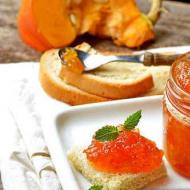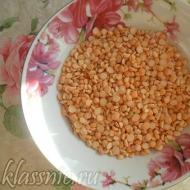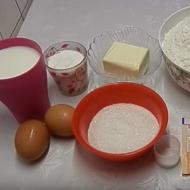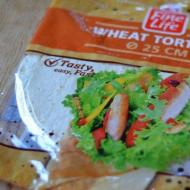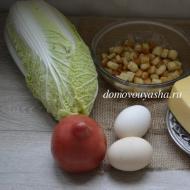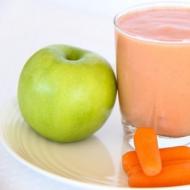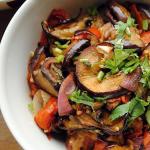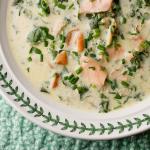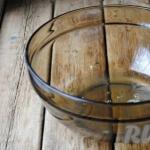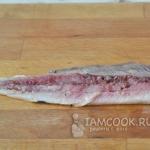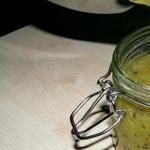
Bran: benefits and harms, tips for use. Bran - types, beneficial properties and recipes for use for health. Benefits of bran for the body.
Another straw that those losing weight clutch at is eating bran (rye, oat, wheat, buckwheat, corn, rice, millet). It is actually a by-product of processing grain into flour. Side effects do not mean bad or useless. Nutritionists and healthy eating enthusiasts recognize the beneficial properties of bran in the fight against excess weight. In addition, this dietary supplement helps improve digestion, get rid of chronic constipation and achieve the desired lightness.
We have already started talking about the most popular bran -. In addition to them, rye bran (which came into fashion after the advent) is in active demand among those losing weight, the benefits and harms of which are somewhat different from other types. We'll talk about them.
About calories, benefits and daily value
What nutritional and energy value do rye bran have? Their calorie content is about 220 kcal, or 920 kJ, per 100 g of product. This amount of pure rye bran contains 15 g of protein, 3.5 g of fat and 30 g of carbohydrates. Not much, provided that 100 g of bran can (and should) be spread over two to three days.
But the main advantage of rye bran is the presence of a large amount (about 40%) of coarse dietary fiber (). It is this component that allows bran to become the best friend of digestion and helps you forget about constipation. Dietary fiber promotes the proliferation of beneficial bacteria in the large intestine, which means it prevents the development of dysbiosis.
Bran is recommended for diabetics, as it can significantly reduce the glycemic index of any product. And the substance beta-glucan, which is part of bran, is a regulator, as it helps to bind and remove fatty acids.
Rye bran absorbs and promotes the expulsion of heavy metal salts and radionuclides from the body. Rye bran binds and removes carcinogens, performing an oncological protective function.
Manufacturers indicate on the packaging of bran the daily permitted consumption rate. Usually – 30–60 grams, subject to proper drinking regimen (about 2 liters of clean water). This applies to both granulated and ground bran.
Please note that you need to introduce rye (and any other) bran into your diet gradually: in the first week, no more than a level teaspoon per day. Further, if the body does not express dissatisfaction, the daily portion of bran can be increased to three tablespoons.
Rye bran affects not only the processes occurring in the gastrointestinal tract. So, they are used as a proven folk remedy for bronchitis. Take 100 g of rye bran per 0.5 liter of water and cook the mixture over low heat for about an hour. Add 50 g of lemon juice to the finished broth. The drug is drunk an hour before meals, half a glass. This remedy will help remove phlegm and curb cough. Interestingly, the same recipe is also indicated for hypertensive patients to lower blood pressure.
How to start the weight loss process?
Due to the presence of dietary fiber and low calorie content, many people use rye bran for weight loss. Weight loss here is based on three main factors:
- fiber fills the stomach and helps you feel full with less food and control your appetite;
- consuming rye bran prevents carbohydrates from being actively absorbed into the blood;
- Rye bran plays the role of a natural scrub for the stomach and adsorbent - it absorbs toxins and helps remove toxins from the body.
As a stimulant for weight loss, bran is taken half an hour to an hour before meals to curb appetite. You can also replace breakfast with bran and kefir. An evening snack can be the same, then you definitely won’t get full at night.
To be fair, we note that any bran works well to control appetite and cleanse the body. A pleasant bonus of rye is the presence of B vitamins, as well as the mineral salts of magnesium, potassium, iron and phosphorus necessary for the body. Of course, if we are talking about natural bran - not steamed or granulated. But even processed pharmaceutical analogues do not lose their main advantage - dietary fiber.
The truth speaks through the lips of those losing weight
Bran of various brands and types has earned many positive words on the Internet. Rye bran, reviews of which we analyzed, is praised for its taste, effectiveness in improving digestion and weight loss, as well as for its affordable price. For example, a girl under the nickname Lucien talks about her acquaintance with granulated bran:
“With proper nutrition, exercise and this bran, I lost 3 kg in a week. I ate this bran in batches, because... they have a lot of protein and are very light (both in weight and in calories). With plain yogurt, kefir or milk. They are crispy, like crackers, very tasty, as if you were eating bread, but at the same time it’s not bread, but a healthy product!”
And user Tanushka_87 shares the positive effects of rye bran on hair and skin:
“My dandruff disappeared, my hair stopped getting very oily, and the skin on my whole body became smooth. For 4 weeks now I’ve been eating them in the morning, and a little during the day... And I feel great.”
Shall we crunch?
So, you bought your first pack labeled “rye bran” - how to use it to improve your health and diversify your diet? With granulated ones, everything is simple: you can crunch them to your heart’s content. We close our eyes and imagine that we are enjoying Kirieshki (there is a distant similarity if you choose bran with seasonings and additives). The main thing is not to forget to drink it with water – you can drink it not only with water, but also with any fermented milk (kefir, yogurt, etc.), juice. Some people replace bread with it and eat granulated rye bran as a “bite” in soups.
“Lazy” ways to use ground rye bran are to stir a tablespoon or a half in a glass of kefir and let it sit for 15–20 minutes, sprinkle it on a salad, stewed vegetables or first course, and add it to the minced meat for cutlets. And to control your appetite, you can simply steam a spoonful of ground rye bran in hot water (not boiling water!) and eat it half an hour before meals, washing it down with plenty of clean water.
For those who love culinary experiments, here are several recipes with rye bran. These dishes are very light and help improve digestion. They can be included in the diet during periods of fasting and weight loss.
Summer cold soup with rye bran (with kefir)
For 2 servings, take: two glasses of 1 or 2.5 percent kefir, three medium fresh cucumbers, a large boiled cucumber, one hard-boiled cucumber, 40 g of rye bran, green onions, or other favorite greens.
We cut the vegetables into cubes, chop the greens, mix everything and pour in kefir (if desired, it can be slightly diluted with water), salt to taste and add ground bran. Mix well and pour into plates. Before serving, decorate each serving with half an egg and herbs.
Light salad with seaweed, crab meat and bran
We cut into strips 100 grams of crab meat (ideally natural, but for lack of anything better, you can take a package of crab sticks), cucumber and tomato (pull out the liquid insides so that the salad does not “float”). Add 200 grams of pickled seaweed and 2 tablespoons of ground rye bran. Mix the ingredients and let the salad “rest” for about 15 minutes. Before serving, add a little salt and season with lemon juice.
Pasta with added bran
If you are confident in your culinary talents, you can make your own pasta at home.
Mix five parts flour and part rye bran, add a pinch of salt and knead a stiff dough in cooled boiled water. Let the dough rest for about half an hour, covered with a clean napkin. Then roll out as thin as possible, let dry a little and cut into small strips.
You can cook the pasta right away; keep in mind that it takes a little longer to cook than store-bought pasta. You can season the finished dish with either low-fat sauce. If you have a lot of pasta, you can dry it well and store it in an airtight container.
Dessert with rye bran for losing weight
Pour rye bran (one part) with a small amount of boiling water. Add (one part) and (two parts) to the steamed bran. Pass everything through a meat grinder. Eat with tea or kefir.
Not bran alone...
Rye bran, the benefits and harms of which are mainly associated with the presence of a large amount of dietary fiber, should be eaten without fanaticism. If you do not maintain the daily intake of bran, or if you do not drink plenty of fluids in parallel with their absorption, you can achieve undesirable consequences. In the best case, you will simply feel discomfort and heaviness in the stomach, gas formation will increase and stool will become loose, in the worst case, the formation of fecal stones will begin.
For any diseases of the gastrointestinal tract, it is better to avoid consuming different types of bran, including rye bran. At the very least, don't take risks without consulting a doctor.
It is important to know that consuming bran reduces the absorption of drugs. Therefore, during active treatment, you should avoid consuming rye and other bran. In addition, if you suffer from individual intolerance to cereals, rye bran can cause an allergy attack.
And finally, advice from nutritionists: in the summer, when it is possible to consume more natural foods rich in fiber - fruits, herbs and vegetables, it is better to reduce the consumption of bran or remove it from the diet. Bran can be added to food in courses, but not constantly, as it reduces the absorption of minerals and vitamins.
Bran, the benefits and harms of its use, have been widely studied by gastroenterologists and nutritionists. Currently, more and more people are consuming this nutritious and low-calorie product in order to get rid of extra pounds. Why are they so popular among those who want to lose weight? What healing effect do they have on the human digestive system? Why is it so important not to overdo it when adding this product to your diet? What types of bran are there? – You will find out the answers to these questions by reading the article.
Benefits of use
Bran is a product of processing cereal grains into flour. The hard shell, husk and particles of grain that remain when grains are ground into flour. Their widespread use in dietetics is due to their availability, low price and good therapeutic effect in the fight against various problems in the human body. They contain 2 times more polyunsaturated fatty acids Omega-3 and Omega-6 than animal products.
Due to the large amount of vegetable fat, bran quickly becomes rancid. For this reason, the grains are peeled to preserve the high quality of the flour for as long as possible. Removing the hard layer deprives the grain of a large amount of beneficial nutrients that are essential for the human body. There are practically no useful minerals and fiber left in the flour obtained in this way. Baking from it turns out empty, without enzymes, dietary fiber and vitamins. The removed shells retain more fatty acids, protein and microelements than the grain from which they were obtained.
To eliminate this drawback, it is useful to add ground bran to flour when baking bread. Bread made from such enriched flour will provide the body with valuable fiber, which will help strengthen intestinal motility, helping to get rid of constipation.
Bran is rich in vitamins, most of all B vitamins and vitamin E. These vitamins are vital for the human body, have a healing effect on the nervous system, promote skin regeneration, cell nutrition, participate in the production of hormones, protein synthesis, and help strengthen the immune system. Sufficient consumption of plant foods rich in vitamin B helps to avoid deficiency of this vitamin in the body, this is especially important for vegetarians and raw foodists.
Types, composition and calorie content
Based on the degree of grinding, granulated and ground bran are distinguished. Depending on the grain from which they are produced, there are:
- wheat,
- rice,
- oatmeal,
- rye,
- buckwheat,
- linen,
- corn.
Wheat bran is low in calories and contains more copper and zinc than other types. Rice contains many microelements, in particular iron. Oat bran is somewhat inferior to wheat bran in mineral composition. Rye bran is rich in amino acids, Omega-3 and Omega-6 fats, iodine, and selenium.
Buckwheat bran contains the most useful substances. At the same time, they are the most high-calorie, they contain a lot of plant protein, similar in composition to protein of animal origin. Flax bran, which has very high benefits for the body, has the same beneficial properties as flax seeds. They have a high positive effect on the digestive system. Corn bran contains the least amount of useful minerals.
The big advantage of rice, buckwheat, flax and corn bran is that they do not contain gluten. This is a plant protein that is a fairly strong allergen; it is not tolerated by people with an autoimmune disease of the digestive system - celiac disease.
When and how to use
Bran is often used for the purpose of losing weight. Their high dietary effect is associated with the ability to retain water. Acting as a natural absorbent, entering the digestive tract, they absorb water and increase in size. Thus, the impression of a full stomach is created, rapid saturation occurs and appetite decreases. Bran is not digested in the stomach; after swelling, it enters the intestine, where it is digested by beneficial microflora. They serve as a kind of brush for the intestines and stomach, absorbing toxins and cleansing the mucous membranes of harmful substances. Due to their low calorie content and the absence of cholesterol, they do not lead to excess weight gain even with regular use.
It is worth noting that coarse dietary fiber should be taken in food only in courses, since their excessive intake into the human body leads to a decrease in the absorption of beneficial microelements and disruption of the functions of the gastrointestinal tract.
A diet containing sufficient amounts of bran (the norm is no more than 30 g per day for an adult) helps to cope with diseases such as:
- chronic constipation,
- proctitis,
- intestinal dyskinesia,
- diverticulosis,
- irritable bowel syndrome,
- cardiac ischemia,
- atherosclerosis,
- diabetes,
- hormonal imbalance in the female body.

Before introducing bran into your diet, you should consider that ground and granulated types are prepared differently. Particles of hard grain shells, crushed to the consistency of flour, must be soaked in warm water and left for 30 minutes before use. The result will be a kind of porridge in which all the vitamins and minerals necessary for health will be preserved. You can add sweetener, salt, juices, etc. to taste. Oat, flax and rice bran are considered the most suitable for preparing porridge.
Simply add granulated bran to water or juice and let stand for 5 minutes. After this they are ready to eat. The exception is rice granules; they must first be brewed with hot water and allowed to brew for 15 minutes.
You can add bran to ready-made vegetable dishes, porridges, jelly, compotes, and desserts. It is not recommended to eat them dry, as this puts a lot of stress on the digestive system. It is imperative to increase water consumption, since a large amount of liquid is required to perform cleaning functions.
Contraindications
Excessive consumption of bran negatively affects the intestines' ability to absorb nutrients from food. As a result of frequent cleansing of the body with the help of coarse dietary fiber, the functioning of the intestinal villi, which are responsible for the process of absorption of macro- and microelements, is disrupted.
Raw bran contains a large amount of substances that interfere with the absorption of iron and calcium not only from the bran itself, but also from other products. In order to neutralize phytates, it is necessary to heat-treat the bran, for example, add it to flour or cereal. In the process of preparing baked goods or porridge with bran, most of the harmful substances will be neutralized.
It is not recommended to eat any types of bran, including rice bran (despite the property of rice to fix stool) for diarrhea and diseases of the gastrointestinal tract. Strictly prohibited - for stomach ulcers, duodenal ulcers and ulcerative colitis. Children are allowed to introduce them into their diet from the age of 3, no more than 10 g per day with mandatory monitoring of fluid intake.
Bran is a product that has been used since ancient times to treat digestive problems, and then undeservedly forgotten. Today, the beneficial properties of processed cereal shells have been proven. Nutritionists around the world recommend eating bran.
What are bran?
Any grain consists of an embryo, a starchy layer and a shell. By the time the cereals are sent to flour mills, all the biologically active components of the starchy layer die off, losing their beneficial properties. Living cells remain only outside. During processing, it is this part of the grain, as well as the germ and skin, that is eliminated (“chopped off,” i.e., becomes bran). The flour contains a starchy layer of grain that does not have any beneficial properties.
So, bran is a product of cereal processing, which contains many biologically active substances, vitamins, minerals, micro- and macroelements.
They consist mainly of coarse dietary fiber (fiber), the benefits of which should not be underestimated. This product is also a source of vitamins A, E, and group B. Bran also contains magnesium, zinc, potassium, calcium, fluorine, and selenium. There are other macroelements in cereal processing products, but in small quantities.
Product Types
Bran can be found in stores, on shelves with dietary food. The most commonly sold products are wheat, but in general there are processed products from any cereal. What types of bran are better - wheat, rye or oat? How do their properties differ? What are the benefits of bran?
Oatmeal is an excellent product for preventing colorectal cancer. They are good at removing carcinogenic substances from the body.
Rye grains are a source of polyunsaturated fatty acids - natural antioxidants that slow down the aging process and neutralize the effects of carcinogens. In addition, rye processing products increase immunity and are very useful during the cold season.
It doesn’t matter what kind of bran you eat – oat bran, buckwheat or others – because they have a common property – they cleanse not only the intestines, but the entire body from various harmful substances.
A real “brush” for the intestines
In the middle of the 20th century, nutritionists turned their attention to fiber (dietary fiber). It turns out that if a person does not eat rough, poorly digestible food, problems with the gastrointestinal tract begin: constipation, bloating, flatulence. Harmful substances that accumulate in the body lead to various diseases, including cancer.
Fiber (which all types of bran contain in large quantities) acts as a brush for the stomach and intestines. It does not allow food to “stagnate”: everything that is not absorbed in the stomach quickly passes into the intestines and is excreted from the body. To get fiber, it's best to eat a handful of bran. On the way to the intestines, they get wet, swell, and become like a soft sponge. It collects all the most harmful deposits from the mucous membrane of the digestive system, absorbs heavy metals and everything unnecessary that is in the body. Then it removes toxins outside.
As a result of the absorbent properties of the product, constipation, cramps, and increased gas formation disappear. The entire digestion process is improved.

Use for skin
A person's appearance is directly related to his health. Good digestion, the absence of toxins and breakdown products in the body is the key to clean, smooth skin, healthy hair, and strong nails. In this sense, bran can become an indispensable supplement to your diet.
In addition, this product is a source of vitamins A and E. The first has a positive effect on the skin, giving it density and elasticity. The properties of this substance make it useful for the prevention of myopia and farsightedness.
Vitamin E promotes hair growth and strengthens nails, heals small wounds on the skin, smoothes out fine wrinkles. You start to look much better.
You can make anti-aging masks using bran. Take 2 tablespoons of a finely ground product and one yolk of a raw chicken egg, mix. Add a teaspoon of warm water and wait until the mixture swells. Stir the mask until smooth. Lubricate your face with the resulting mass, leave for 15-20 minutes, then rinse.
Application for weight loss
Bran is an excellent solution for those who are losing excess weight and at the same time want to improve their health. The fact is that this product is very hygroscopic. Absorbing moisture, it swells several times. The mass fills the stomach, causing a person to feel full. While it is being digested (and this takes a very long time due to the high fiber content), you will not feel hungry. The product can be used to replace one meal or add it little by little to different dishes.
But don't get too carried away! Nutritionists recommend eating no more than 2 tablespoons of the product per day if you want to cleanse your body. If the goal is weight loss, then you need to consume 2 tablespoons of bran 15 minutes before meals 3 times a day. To get rid of constipation, eat 1 tablespoon of this product 3 times a day before meals.

Other benefits
This product is very useful for the nervous system. Due to the content of magnesium and B vitamins, it relieves irritability, anxiety, and stress. Bran has calming properties; They help well with hot temper and tearfulness in women at the beginning of the cycle.
Cereal purification products are indicated for the prevention of diabetes and atherosclerosis. They stimulate metabolism and help cleanse the bloodstream of cholesterol plaques.
Contraindications for use
Bran should not be eaten if:
- stomach ulcer;
- duodenal ulcer;
- acute gastritis.
Do not eat dried bran straight from the package. In order for the product to be beneficial, it is better to slightly soak it or at least wash it down. You can soak the bran in boiled water, in jelly, wash it down with herbal tea, juice, compote - whatever you like. Add a tablespoon of the product to cereals, soups, various casseroles, and stews.
Porridge "Morning"
You will need:
- any bran (oat, wheat, rye) – 2 teaspoons;
- water - glass.
In the evening, cover the bran with water and place it in the refrigerator. In the morning, eat the resulting porridge.
Tonic decoction
You will need:
- any bran (oat, wheat, rice, rye) – 1 tablespoon;
- water – 2 glasses;
- honey – 1 tablespoon.
Boil the water. Place the bran in a saucepan, add boiling water, and simmer for 40 minutes over low heat. Turn off the gas, add honey, stir well. Pour the broth into a jar with a tight lid and take 50 ml 3 times a day. The finished drink should be stored in the refrigerator.
Bran is a wonderful product for those who want to improve their body's health. Dietary fiber is an important element of the human diet. There are a lot of them in bran. By eating this product, you will cleanse the gastrointestinal tract, normalize blood pressure and metabolism. Include it in your diet, and soon you will enjoy the results.
Expert opinion

Regarding weight loss, bran is indeed often recommended to be added to the diet. And here many begin to act on the principle “the more, the better.” Like, I’ll eat more bran and lose weight faster. Everything needs moderation. I would recommend consuming no more than 2 tablespoons of bran per day, even if you are on a diet. And don't forget that fresh fruit is another great source of fiber. Eat them in the first half of the day, without mixing them with other foods - this way they will bring maximum benefit.
Alina Semenova, nutritionist
Quite often, people trying to lose weight are advised to give up sweets, fatty foods, and starchy foods. And here many people ask: “Do we really need to give up all this?” Cakes, buns, cakes - this is understandable, we boldly say to all of this: “Goodbye” or even “Farewell”. But bread, it contains a lot of useful substances, vitamins and microelements? People have been using it for centuries and never even thought about giving it up?
Yes this is true. But let's think about it: is this the bread we buy and eat now? What kind of bread did many generations of our ancestors eat before us? After all, they ate bread made from unrefined grains, that is, whole grain bread. But it is known that all vitamins and microelements are contained precisely in the grain shell or, in other words, in the bran.
We would all be healthier and live longer if we ate roughage, which provided more indigestible fiber for the digestive tract. According to its chemical composition, food fiber is non-digestible cellulose. In terms of its content in products, food bran comes first (53–55% fiber), then vegetables (20–24%) and rye bread.
According to the American Dietetic Nutrition Association, the recommended fiber intake for men is at least 38 grams per day, and for women - 25 grams per day. However, according to research conducted by this organization, the current average amount of fiber consumption in the world is only 15 grams per person.
Health benefits of bran.
Bran is a form of complex carbohydrates having a low glycemic index. Bran can also lower the glycemic index of other foods. This is a natural product that consists of grain shells and unsorted flour. They contain a complex of B vitamins necessary for humans, which are directly involved in lipid metabolism. Bran contains vitamins B1, B2, B6, PP, as well as provitamin A (carotene) and vitamin E. Bran is rich in minerals. Among them are potassium, magnesium, chromium, copper, selenium and other trace elements. Thanks to this composition, bran is an indispensable dietary product, a particularly important addition to the diet of obese patients.
One of the main advantages of bran is its high content of dietary fiber, which regulates intestinal function, improves colon microflora, helps eliminate cholesterol, and lowers blood sugar. The dietary fiber contained in bran lowers cholesterol by binding intestinal bile acids, which are known to have a certain atherogenic activity, therefore bran can be used to prevent atherosclerosis. The positive effect of bran in diabetes mellitus is due to the slowdown in the breakdown of starch and the ability to influence the glycemic index of other products.
Bran has low nutritional value. As they pass through the digestive tract, they accumulate liquid and swell, creating the illusion of satiety, and thereby reducing the amount of food consumed. They adsorb bile acids, toxins, bind and remove nitrates from the body that enter the body with vegetables and fruits. Helps detoxify the body.
The dietary fiber found in bran is a form of complex “good” carbohydrates. It is a type of cellulose, a plant fiber. It is a nutrient medium for normal intestinal flora, so bran is indispensable in the complex treatment of intestinal dysbiosis. The choleretic effect of bran is ensured by their stimulating effect on the general motor ability of the digestive tract (mechanical stimulation).
The cleansing effect of fiber is explained by the hollowness of its fibers. As you know, nature abhors a vacuum and, when it enters the gastrointestinal tract, fiber absorbs everything that has accumulated in our intestines over many years. It absorbs mucus that clogs microfolds, cleaning their entire surface for complete contact with food masses. We can observe similar cleansing processes in the stomach. Fiber is somewhat similar in properties to activated carbon.
Since ancient times, people have known and used the healing properties of bran to treat diseases of the gastrointestinal tract. But more recently, another property of fiber has been discovered - its ability to influence metabolism. But it is metabolic disorders that lead to weight gain. Fiber does not burn fat, does not affect the visible consequences of excess weight, but affects the cause itself - a violation of metabolic processes in the body.
Bran helps improve colon peristalsis, acting as a stool-forming factor and a surefire remedy for constipation. They create a large soft mass, which accelerates intestinal motility and, diluting itself, lowers the levels of fat breakdown products associated with the formation of carcinogens. Regular consumption of bran can relieve habitual constipation and prevent its occurrence in the future, after stopping bran intake (restoring the normal bowel movement reflex).
Some groups of African aborigines, who eat almost no meat and milk, usually have semi-liquid stools, and they have an order of magnitude lower incidence of polyps and colon cancer than residents of developed countries who consume refined foods. There is an opinion about the possibility of a connection between chronic constipation and the development of colon cancer. In particular, it is known that in some countries and regions, the incidence of colon cancer varies sharply, with differences that can be as much as 20-fold, and this difference is directly related to the dietary patterns in these regions.
In the form of a dietary supplement, bran is effective for dysfunction of the liver, gallbladder, pancreas, chronic diseases of the stomach and intestines - gastritis, gastroduodenitis, enterocolitis during the period of remission and subsidence of the acute inflammatory process. But bran is of particular importance in the treatment of obesity and diabetes.
How to use bran correctly.
Bran should be taken with food, added to dishes, or outside the main meal, with milk, kefir, yoghurt or other dairy products, 3-4 times a day. The daily dose of bran is 30–50 grams. But when treating obesity, this rate can be gradually doubled.
If you have not used bran in your diet before, then you need to start with small doses - 1-2 teaspoons per day, for a week, bringing the volume to the maximum comfortable daily dosage. This way you can avoid the unpleasant consequences that arise when quickly introducing a large amount of fiber: increased formation of gases, stool instability, heaviness in the abdomen.
It's true that many of us don't get enough fiber from our diets, and suddenly increasing your fiber intake can interfere with your body's ability to absorb certain minerals such as zinc, calcium, iron, magnesium, and vitamin B12.
Of particular importance is zinc deficiency, which inevitably develops with long-term intake of bran, and this microelement plays an important role in lipid metabolism. Professional nutritionists, knowing this, be sure to promptly introduce zinc-rich foods into the diet, and above all, almonds.
Bran is recommended to everyone as a preventive and health remedy necessary for proper functioning of the intestines, lowering cholesterol levels in the blood, cleansing the digestive tract of waste and toxins, but they play a special role in restoring metabolism and treating obesity. Their use with daily meals actually suppresses appetite and reduces weight.
Bran and pectins have a binding capacity of 300–400 g of water per 100 g of substance. At the same time, the obligatory condition for their use is (1.5–2 liters per day), without which fiber ceases to perform its adsorbing function. When treating patients, especially the elderly, who often have fluid deficiency, it is necessary to pay attention to sufficient fluid intake. Considering the possibility of fiber binding calcium, iron and zinc with the occurrence of subsequent disorders of mineral metabolism, its dosage should be individually carefully selected.
Bran is a very healthy and low-calorie product.
For those who want to abstain from a heavy dinner in the evening, this is an indispensable way out. A glass of kefir or yogurt with bran will perfectly fill you up and help you cope with hunger.
But! There are also restrictions! Bran is not recommended for use in the acute period for gastritis, peptic ulcers, colitis and enteritis of infectious etiology, as well as for adhesive disease. However, after the inflammatory process subsides, taking bran can be resumed, starting with small doses.
The released gases can increase the distension of the colon, which, on the one hand, stimulates intestinal motility, and on the other hand, can lead to flatulence. The possibilities of increasing the content of bran in food are often limited by their varying individual tolerance and, first of all, due to increased gas formation and increased flatulence.
From all this we can conclude that bran is recommended for almost everyone for daily, constant use.
Based on materials from the book Kovalkov A.V. "How to lose weight? Strategy for defeating weight"
Recipes for bran dishes.
Bran fritters: 25 grams of bran, 20 grams of flour, 50 grams of cottage cheese, 100 ml of kefir, 100 ml of water, salt, sugar to taste, baking powder. Mix everything in a blender or by hand and let the dough sit for 20 minutes. Fry over very low heat. Take your time to turn over. Let the dough set.
Healthy smoothie with bran for breakfast: For 2 large cups: 5-7 prunes, 1 tbsp. bran, 0.5 liters of kefir (by eye, depending on the size of the cups)
Do you know how to take wheat bran, the benefits and harms of which have been repeatedly reviewed by leading nutritionists? The effect of this product is ambiguous. With the right approach, it helps to replenish the deficiency of missing substances. But this does not mean that bran can be eaten in any quantity. Rational nutrition is about maintaining a balance between the intake of elements. For bran, as for any other additive, there are rules and regulations for use.
Bran is a secondary product obtained during the production of flour. It consists of the outer hard and difficult-to-digest grain shells.
The main value of bran lies in its high content of coarse fibers.
Fiber should be present in the diet of any person. Plant fibers stimulate the gastrointestinal tract. Their lack acutely affects not only digestion, but also metabolic processes throughout the body.
Coarse fibers have low nutritional value. They are not digested in the stomach and small intestine, but are successfully decomposed in the lower gastrointestinal tract, turning into oligo and polysaccharides.
Complex carbohydrates become food and promote the growth of beneficial bacteria. Food enriched with coarse fiber helps restore internal flora, so bran can be used to prevent dysbiosis.
Plant fibers not only create conditions for the growth of beneficial microorganisms, but also mechanically stimulate the gastrointestinal tract. Fiber swollen in water expands the walls of the intestinal tube, causing a response. The stretched muscles of the digestive tract, trying to return to their original shape, actively contract. As a result, peristalsis increases. Food moves faster through the gastrointestinal tract.

The intestinal tract must receive the necessary load daily. This reduces the likelihood of atony, constipation and diseases arising from digestive disorders.
Fiber actively binds cholesterol and prevents its excess absorption. A diet rich in plant fiber is effective in preventing cardiovascular diseases, coronary heart disease and hypertension.
Bran is useful for people suffering from diabetes. They lower the glycemic index of food by binding excess glucose. Thus, the herbal supplement can be used to prevent diabetes, as well as be included in the diet of those already struggling with this disease.
Coarse fibers are an effective natural sorbent. They absorb toxins formed as a result of food oxidation, take on heavy metals, and neutralize metabolic products.
Thus, bran compensates for the deficiency of dietary fiber. Their influence has a positive effect on metabolism throughout the body. Bran reduces the level of slagging and helps prolong youth and health.
Composition and calorie content
For a long time, bran was considered an unnecessary product. The outer shells of grains contain a lot of fatty acids, which cause whole grain products to spoil quickly. To extend the shelf life of white flour, they try to clean it as much as possible from coarse impurities.
White flour has a higher commercial and consumer value. It is much more often used in the food industry. In the 20th century, bran practically disappeared from the human diet.

White flour is more nutritious than whole grain flour, as it consists to a greater extent of easily digestible starch and simple sugars. But it has low biological value; it contains significantly less essential acids, vitamins and minerals.
Bran does not have such great nutritional value, but plays a serious role in replenishing biologically important compounds.
The husk contains much more useful substances than the wheat grain itself and the flour obtained from it.
The rough shells contain a small amount of energy (216 kcal). They contain virtually no sugar (0.4%), but contain a huge amount of dietary fiber (43% versus 10% in whole grains).
Due to the high protein content (16%), flour production waste is quite nutritious. Compared to the original product, bran contains twice as much beneficial fatty acids (4.3%), including essential ones. The outer shells of the grain are rich in B vitamins, which are responsible for the growth and renewal of cells and tissues.
The food supplement is rich in minerals. When 100 g of bran is burned, 5 g of ash residue is formed. The non-burning substrate contains microelements such as phosphorus, potassium, magnesium, calcium, iron and zinc.
Dosage per day
According to information from various sources, the norm for consuming bran per day ranges from 16 to 50-60 g. You can navigate by the number of teaspoons. One unit contains 4 g of product. On average, manufacturers recommend eating 2 teaspoons 2-3 times a day.

Different packages may contain different information. Bran is a natural product in which the amount of substances may vary depending on the composition of the raw materials. Very often, salt, sugar, herbs, fruits, berries, artificial and natural flavoring and mineral additives are added to the finished bran. Therefore, the rate of use will depend on the final composition of the product.
The supplement should be introduced into the diet carefully. Starting with a teaspoon once a day, gradually (over 1-2 weeks) increasing the amount to the daily norm. When taking husks, be sure to follow a drinking regime (at least 2 liters of water per day).
How to use it correctly for weight loss?
The benefits of wheat bran for weight loss are obvious. The product has a low calorie content and helps speed up metabolism. Swelling in water, it increases in volume, fills the stomach and gives a feeling of fullness.

To reduce weight, bran is consumed before meals. They are pre-soaked in water or kefir, the excess liquid is drained and the thick, swollen mass is eaten. If you repeat this three times a day, you can significantly reduce the amount of food you eat and, accordingly, get rid of extra pounds.
Use in folk medicine
In folk medicine, bran is used as a general tonic. They are boiled a little, mixed with honey and eaten throughout the day. A hot decoction of bran and burnt sugar is drunk as an expectorant for respiratory tract infections.
Grain husks are an excellent remedy for constipation. Bran is washed down with plenty of water. Most often they eat it once at night. Or consumed together with kefir during the day as a cleansing and laxative.

Due to the high content of vitamins, minerals and fatty acids, bran has a beneficial effect on the skin. They take baths, prepare masks and facial scrubs.
Cereal hull powder is included in the diet to reduce blood cholesterol levels. Official studies confirm that with such a diet, its concentration is sometimes reduced by 30%.
Diabetic patients use a dietary supplement in their diet to lower the glycemic index of the food they eat. Bran is sprinkled on prepared dishes. Be sure to wash down your food with plenty of water.
Recipes for dishes made from wheat bran
You can not only eat bran yourself, add it to food, but also cook delicious and healthy dishes with it.
The simplest dish is buckwheat porridge with bran. The cereal must first be boiled and left to simmer under the lid. At this time, fry the onion and bran in a frying pan in butter until the products acquire a golden hue. All ingredients are mixed and salted to taste. For 100 g of boiled buckwheat, take about a glass of bran.

Okroshka with kefir– a dish that improves digestion and helps fight excess weight.
To prepare it you will need:
- fresh cucumber;
- boiled egg;
- half boiled beets;
- greens (preferably onions with feathers).
Chop everything into cubes and place in a bowl. Season with kefir, half diluted with water. Add bran (30 g per serving), salt and sour cream to taste to the finished dish. Stir and let it brew a little.
You can make a substitute for bread bran cakes. To do this, you will need to heat 100 g of sour cream in a water bath so that it becomes liquid and fluid, but does not have time to curdle.

In a separate container, beat a chicken egg with a spoonful of granulated sugar until it forms a stable foam. Combine both substances. Add to them 60 g of bran and 40 g of hard grated cheese.
Form the dough into flat cakes. Place on a greased baking sheet. Bake in the oven at 180°C until done (about 30 minutes).
Can it be given to children?
Most often, the instructions for using the supplement limit the age at which you can take the product to 12 or even 14 years. For this reason, bran should not be given to children.
Coarse fibers can provoke irritation of fragile intestines, causing bloating, gas formation and constipation.

Sometimes, on the advice of a pediatrician, children starting from 10 months of age are given a bran decoction as a vitamin supplement. A teaspoon of grain husk is poured with half a glass of boiling water. Leave for 30 minutes, strain and add a spoonful to prepared dishes or drinks up to three times a day.
This drink promotes digestion and strengthens the immune system. The minerals contained in bran have a positive effect on the growth and development of the musculoskeletal system.
Possible harm from consumption
The influence of bran is not clear. You shouldn't get carried away with them. It is better to use courses with breaks, after consulting with your doctor.
Despite its natural origin, the dietary supplement has contraindications.

- adhesions in the gastrointestinal tract;
- erosive and ulcerative lesions of the mucous membranes of the stomach or intestines;
- inflammatory diseases of the alimentary tract in the acute stage;
- obstruction.
In these cases, an active effect on the intestinal walls can lead to an exacerbation of the underlying disease.
In addition, excess dietary fiber in the diet causes the opposite effect in the form of bloating, constipation, increased gas formation and intestinal pain.
Bran, as a natural sorbent, partially absorbs beneficial substances from food. Their active use can lead to a lack of vitamins and minerals.
In recent years, many discoveries have been made. Phytic acid was found in bran. According to some researchers, this substance interferes with the absorption of magnesium, calcium, iron and other trace elements from food, so frequent consumption of bran can lead to a deficiency of certain compounds.
The version about phytic acid does not have a final version. At the moment, the controversy continues. It was found that when exposed to temperature, the insidious compound is destroyed. According to the latest recommendations, it is better to consume the grain additive in steamed or cooked form, thus making it less dangerous.
Product selection and storage
On the shelves of shops and pharmacies you can find a wide range of similar products. But not all bran is equally useful. By themselves they have no taste. To make a product more attractive, manufacturers often add salt, sugar, and natural or artificial flavors.
It is worth giving preference to a product with a simple composition, without sugar and “identical to natural” components. Bran should not contain much salt. To solve specific problems, you can choose a fortified product, for example, bran with calcium.

Cereal husks should be stored in tightly closed jars or paper boxes. Protect from moisture and direct sunlight.
In pursuit of health, people sometimes take rash steps. Practice shows that the craze for dietary supplements does not lead to anything good.
Before consuming bran, it is advisable to check your health and exclude possible contraindications. And only then start choosing a high-quality and truly useful product.

